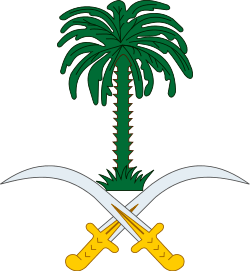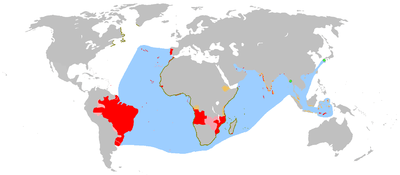Tarout Island


Tārūt Island (Arabic: جزيرة تاروت) is an island in the Persian Gulf belonging to the Eastern Province of Saudi Arabia, connected by two causeways to Qatif. It is six kilometers from the coast, and is the longest island in the Persian Gulf after Qeshm Island, extending from Ra’s Tannurah in the north to Qatif in the west. The island has an area of 70 square kilometers, and a population (1992) of 38,055. It contains a number of towns and villages, including Tārūt itself, Deyrah, and Darīn.
History of the name
It is claimed by some that the name of the island comes from the name of the ancient Phoenician and Canaanite goddess of love Ashtarat (Phoenician "ʻštrt" (ʻAshtart); and Hebrew עשתרת (Ashtoret, singular, or Ashtarōt, plural); Ancient Greek: Ἀστάρτη, "Astártē"). The ancient Arabic name for the place was apparently 'Ishtarut (عشتروت); in the Greek Geographia of Ptolemy it is called Tharrō (θαρρώ); on a map Ptolemy’s Geographia published in Latin in 1578 it appears as Tharro. In the Middle Ages the island was often called Dairin or Daryn, for one of its cities.;[1] Darīn is actually the name of its main harbor, and there have also been more modern attempts to rename it Darīn.[2] The Treaty of Darin was signed on the island in 1915 between Ibn Saud and the United Kingdom.[3]
Archaeology
Archaeological finds indicate that the island has been inhabited since 5000 BC; and it was later home to people from the civilization of Dilmun, Akkadians, Assyrians and Persians. Later it was occupied by the Persian Empire, the Islamic Empire; it was colonized by the Portuguese and later made part of the Ottoman Empire.
In 1959 a man cleaning a street discovered rocks with Sabaean inscriptions on them. The most famous artefacts found on Tārūt were unearthed by Danish archaeologists in 1968; they excavated shards of pottery dating back to 4,500 BC, and others from 3000 BC. When the municipality of Qatīf wanted to build a causeway to Tārūt in 1962 they took sand from the hill known as Tell Rafī’ah, and found Stone Age artifacts, including pottery, and a statue. The last discovery was in 1993 on Tell Rafī’ah. Sometimes archaeological ruins are discovered by accident; something that occurred when a car repair workshop was being renovated and tombs dating back to 2000 BC were found.
Many vessels have been found on Tārūt carved from steatite, particularly from Tell Rafī'ah; the designs are very artistic and include representations of cats, nude men, and motifs connected with the sea and fishing.[4] The source of the steatite was actually in South Western Persia, but the carving industry seems to have been a local one.[5]
Among the ancient statues discovered in Tārūt is one of a naked man made out of dark grey stone. It was found in the 1950s by a man ploughing his field. It is 94 cm high, and the man is standing in a reverential posture, with wide eyes. It is almost certainly Sumerian in origin, though it is was found about 1000 kilometers from the nearest city of Sumer. It is a very high quality object, but was almost destroyed by the superstitious villagers, who thought it had something to do with spirits (jinn), and so cut it in half and beheaded it. It has been restored and now stands the National Museum of Riyadh.[6]
In 1962 when some of the inhabitants of the village of Rabī'iyah were replacing their former thatched houses with buildings of stone and plaster, a man climbing some of the hills looking for stones, they chanced upon a jar, and then discovered a number of graves, which experts later suggested were likely to be Jewish in origin. They also found many earthenware vessels at the same site. At Khārijīyah in the north of Tārūt many clay figurines have also been found.[7]
Coordinates: 26°34′N 50°04′E / 26.567°N 50.067°E
References
- ↑ Royal Geographical Society (Great Britain) (1946). The Geographical journal. Royal Geographical Society. pp. 107–108. Retrieved 4 February 2012.
- ↑ See the webpage: Mawqi' Jazīrat Tārūt, in Arabic, where the question is asked what the name of the island really is: Tārūt or Dārīn. The reply is that it was never historically known as Dārīn, though there have been recent attempts to rename it after the harbor its real name is Tārūt.
- ↑ Abdul-Razzak, S. (1997). International Boundaries of Saudi Arabia. p. 32. ISBN 978-8172000004.
- ↑ Michael Rice, op cit.
- ↑ Michael Rice. Op cit.
- ↑ Michael Rice: The Archaeology of the Arabian Gulf: C. 5000-323 BC. P. 221.
- ↑ Mawqi' Jazīrat Tārūt, webpage; the source given there is: 'Abdullāh Āl 'Abd al-Muḥsin: Min Turāth Jazīrat Tārūt.Pg. 35-36.
External links
- Portuguese Fort at Tarout Island, Splendid Arabia: A travel site with photos and routes
| |||||||||||||||||||||||||||||||||||||||||||||||||||||||
| ||||||||||||||
| |||||||||||||||||||||||||||||||||||||||||||||||||||||||||||||||||||||||||||||||||||||||||||||||||||||||||||||||||||||||||||||||||||||||||||||||||||||||||||||||||||||||||||||||||||||||||||||||||||||||||||||||||||||||||||||||||||||||||||||||||||||||||||||||||||||||||||||||||||||||||||||||||||||||||||||||||||||||||||||||||||||||||||||||||||||||||||||||||||||||

